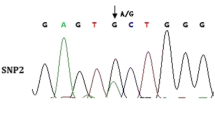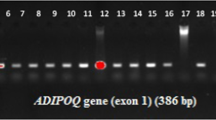Abstract
Adiponectin plays a critically biological role in atherosclerosis, glucose utilization, lipid and carbohydrate metabolism, and triglyceride synthesis in animals and humans. However, little is known about the effect of adiponectin on lipid metabolism of the avian species. The aim of the preset study was to investigate the potential associations between adiponectin gene single nucleotide polymorphisms (SNPs) and the lipid traits in 348 females of Tianzhu Black Muscovy. Three novel SNPs (167G>A, 290T>C and 711G>A) were detected in adiponectin gene. 167G>A and 290T>C has linked very closely, and then 711G>A with 167G>A and 290T>C has no strong linkage disequilibrium, respectively. The Chi square test showed that allelic frequency and genotype frequency of two SNPs (167G>A and 711G>A) didn’t agree with the Hardy–Weinberg equilibrium (P>0.05). Four haplotypes and nine diplotypes were formed on the three SNPs of adiponectin gene. Association analysis indicated that the 167G>A genotypes were strongly associated with intramuscular fat (IMF) of chest muscle and serum total cholesterol (TC) (P < 0.01); the 290T>C genotypes were strongly associated with IMF, TC, and serum triglyceride (TG) (P < 0.01); furthermore, the 711G>A genotypes were significantly associated with TG and TC (P < 0.05); the diplotypes were strongly associated with IMF, TC, and TG (P < 0.01). Therefore, three SNPs in adiponectin were potential markers for improving IMF in Muscovy ducks.

Similar content being viewed by others
References
Dobrzyn K, Smolinska N, Kiezun M, Szeszko K, Rytelewska E, Kisielewska K, Gudelska M, Kaminski T (2018) Adiponectin: a new regulator of female reproductive system. Int J Endocrinol 2018:7965071
Obeid S, Hebbard L (2012) Role of adiponectin and its receptors in cancer. Cancer Biol Med 9(4):213–220
Kiezun M, Smolinska N, Maleszka A, Dobrzyn K, Szeszko K, Kaminski T (2014) Adiponectin expression in the porcine pituitary during the estrous cycle and its effect on LH and FSH secretion. Am J Physiol Endocrinol Metab 307(11):E1038–E1046
Zhang R, Lin Y, Zhi L, Liao H, Zuo L, Li Z, Xu Y (2017) Expression profiles and associations of adiponectin and adiponectin receptors with intramuscular fat in Tibetan chicken. Br Poult Sci 58(2):151–157
Piekarski A, Decuypere E, Buyse J, Dridi S (2016) Chenodeoxycholic acid reduces feed intake and modulates the expression of hypothalamic neuropeptides and hepatic lipogenic genes in broiler chickens. Gen Comp Endocrinol 229:74–83
Mellouk N, Ramé C, Delaveau J, Rat C, Maurer E, Froment P, Dupont J (2018) Adipokines expression profile in liver, adipose tissue and muscle during chicken embryo development. Gen Comp Endocrinol 267:146–156
Rozmilowska I, Czyzewski D, Mazur B, Adamczyk-Sowa M (2018) What is the role of adipokines in myasthenia gravis? Ther Clin Risk Manag 14:1515–1525
Ramachandran R, Maddineni S, Ocón-Grove O, Hendricks G 3rd, Vasilatos-Younken R, Hadley JA (2013) Expression of adiponectin and its receptors in avian species. Gen Comp Endocrinol 190:88–95
Palin MF, Bordignon VV, Murphy BD (2012) Adiponectin and the control of female reproductive functions. Vitam Horm 90:239–287
Wang ZV, Scherer PE (2016) Adiponectin, the past two decades. J Mol Cell Biol 8(2):93–100
Shehzad A, Iqbal W, Shehzad O, Lee YS (2012) Adiponectin: regulation of its production and its role in human diseases. Hormones (Athens) 11(1):8–20
Achari AE, Jain SK (2017) Adiponectin, a therapeutic target for obesity, diabetes, and endothelial dysfunction. Int J Mol Sci 18(6):1321
Sun Y, Chen X (2010) Effect of adiponectin on apoptosis: proapoptosis or antiapoptosis? Biofactors 36(3):179–186
Haider N, Dusseault J, Larose L (2018) Nck1 deficiency impairs adipogenesis by activation of PDGFRα in preadipocytes. iScience 6:22–37
Kocaadam B, Koksal E, Ozcan KE, Turkyilmaz C (2018) Do the adiponectin and leptin levels in preterm and term breast milk samples relate to infants’ short-term growth? J Dev Orig Health Dis 11:1–6
Dai Z, Zhang Y, Ye H, Zhang G, Jin H, Chen Z, Yao Y, Tian X, Zhou J, Li P, Liang X, Xie H, Ge S, Zhang Z (2018) Adiponectin is valuable in the diagnosis of acute heart failure with renal insufficiency. Exp Ther Med 16(3):2725–2734
Yousefian M, Nemati R, Daryabor G, Gholijani N, Nikseresht A, Borhani-Haghighi A, Kamali-Sarvestani E (2018) Gender-specific association of leptin and adiponectin genes with multiple sclerosis. Am J Med Sci 356(2):159–167
Nam JS, Han JW, Lee SB, You JH, Kim MJ, Kang S, Park JS, Ahn CW (2018) Calpain-10 and adiponectin gene polymorphisms in Korean type 2 diabetes patients. Endocrinol Metab (Seoul) 33(3):364–371
Banerjee S, Chaturvedi CM (2018) Neuroendocrine mechanism of food intake and energy regulation in Japanese quail under differential simulated photoperiodic conditions: Involvement of hypothalamic neuropeptides, AMPK, insulin and adiponectin receptors. J Photochem Photobiol B 185:10–23
Huang Y, Haley CS, Wu F, Hu S, Hao J, Wu C, Li N (2007) Genetic mapping of quantitative trait loci affecting carcass and meat quality traits in Beijing ducks (Anas platyrhynchos). Anim Genet 38(2):114–119
Wang DD, Li WG, Zhang YY (2016) Association of CD36 expression and polymorphism with serum biochemical indices in Cherry Valley duck. Genet Mol Res 15(2):1–10
Nei M, Roychoudhury A (1974) Sampling variances of heterozygosity and genetic distance. Genetics 76:379–390
Botstein D, White RL, Skolnick M, Davis RW (1980) Construction of a genetic linkage map in man using restriction fragment length polymorphisms. Am J Hum Genet 32:314–331
Ardlie KG, Kruglyak L, Seielstad M (2002) Patterns of linkage disequilibrium in the human genome. Nat Rev Genet 3(4):299–309
Slatkin M (2008) Linkage disequilibrium—understanding the evolutionary past and mapping the medical future. Nat Rev Genet 9(6):477–485
Yuan J, Liu W, Liu ZL, Li N (2006) cDNA cloning, genomic structure, chromosomal mapping and expression analysis of ADIPOQ (adiponectin) in chicken. Cytogenet Genome Res 112(1–2):148–151
Hendricks GL, Hadley JA, Krzysik-Walker SM, Prabhu KS, Vasilatos-Younken R, Ramachandran R (2009) Unique profile of chicken adiponectin, a predominantly heavy molecular weight multimer, and relationship to visceral adiposity. Endocrinology 150(7):3092–3100
Diot M, Reverchon M, Rame C, Froment P, Brillard JP, Brière S, Levêque G, Guillaume D, Dupont J (2015) Expression of adiponectin, chemerin and visfatin in plasma and different tissues during a laying season in turkeys. Reprod Biol Endocrinol 13:81
Maddineni S, Metzger S, Ocón O, Hendricks G 3rd, Ramachandran R (2005) Adiponectin gene is expressed in multiple tissues in the chicken: food deprivation influences adiponectin messenger ribonucleic acid expression. Endocrinology 146(10):4250–4256
Ramachandran R, Ocón-Grove OM, Metzger SL (2007) Molecular cloning and tissue expression of chicken AdipoR1 and AdipoR2 complementary deoxyribonucleic acids. Domest Anim Endocrinol 33(1):19–31
Chabrolle C, Tosca L, Crochet S, Tesseraud S, Dupont J (2007) Expression of adiponectin and its receptors (AdipoR1 and AdipoR2) in chicken ovary: potential role in ovarian steroidogenesis. Domest Anim Endocrinol 33(4):480–487
Ocón-Grove OM, Krzysik-Walker SM, Maddineni SR, Hendricks GL, Ramachandran R (2008) Adiponectin and its receptors are expressed in the chicken testis: influence of sexual maturation on testicular AdipoR1 and AdipoR2 mRNA abundance. Reproduction 136(5):627–638
Jun Y, Xiao T, Guoyong Y, Min F, Haili Y, Chao S (2014) Recombinant globular adiponectin inhibits lipid deposition by p38 MAPK/ATF-2 and TOR/p70 S6 kinase pathways in chicken adipocytes. Biochem Cell Biol 92(1):53–60
Yan J, Gan L, Chen D, Sun C (2013) Adiponectin impairs chicken preadipocytes differentiation through p38 MAPK/ATF-2 and TOR/p70 S6 kinase pathways. PLoS ONE 8(10):e77716
Yan J, Gan L, Qi R, Sun C (2013) Adiponectin decreases lipids deposition by p38 MAPK/ATF2 signaling pathway in muscle of broilers. Mol Biol Rep 40(12):7017–7025
Yan J, Yang H, Gan L, Sun C (2014) Adiponectin-impaired adipocyte differentiation negatively regulates fat deposition in chicken. J Anim Physiol Anim Nutr (Berl) 98(3):530–537
Gan L, Yan J, Liu Z, Feng M, Sun C (2015) Adiponectin prevents reduction of lipid-induced mitochondrial biogenesis via AMPK/ACC2 pathway in chicken adipocyte. J Cell Biochem 116(6):1090–1100
Jiang RR, Zhao GP, Zhao JP, Chen JL, Zheng MQ, Liu RR, Wen J (2014) Influence of dietary nicotinic acid supplementation on lipid metabolism and related gene expression in two distinct broiler breeds of female chickens. J Anim Physiol Anim Nutr (Berl) 98(5):822–829
Yuan P, Yu Y, Luo J, Tian F, Zhang H, Chang S, Ramachandran R, Zhang L, Song J (2012) Lipoprotein metabolism differs between Marek’s disease susceptible and resistant chickens. Poult Sci 91(10):2598–2605
Tahmoorespur M, Ghazanfari S, Nobari K (2010) Evaluation of adiponectin gene expression in the abdominal adipose tissue of broiler chickens: feed restriction, dietary energy, and protein influences adiponectin messenger ribonucleic acid expression. Poult Sci 89(10):2092–2100
Stuber EF, Verpeut J, Horvat-Gordon M, Ramachandran R, Bartell PA (2013) Differential regulation of adipokines may influence migratory behavior in the white-throated sparrow (Zonotrichia albicollis). PLoS ONE 8(6):e59097
Liu X, Cao G, Zhou J, Yao X, Fang B (2017) The effects of bacillus coagulans-fermented and non-fermented Ginkgo biloba on abdominal fat deposition and meat quality of Peking duck. Poult Sci 96(7):2264–2273
Cao Z, Li J, Luo L, Li X, Liu M, Gao M, Yin Y, Luan X (2015) Molecular cloning and expression analysis of adiponectin and its receptors (AdipoR1 and AdipoR2) in the hypothalamus of the Huoyan goose during different stages of the egg-laying cycle. Reprod Biol Endocrinol 13:87
Mellouk N, Ramé C, Barbe A, Grandhaye J, Froment P, Dupont J (2018) Chicken is a useful model to investigate the role of adipokines in metabolic and reproductive diseases. Int J Endocrinol 2018:4579734
Jiang L, Zhu X, Rong J, Xing B, Wang S, Liu A, Chu M, Huang G (2018) Obesity, osteoarthritis and genetic risk: the rs182052 polymorphism in the ADIPOQ gene is potentially associated with risk of knee osteoarthritis. Bone Joint Res 7:494–500
Jafarikia M, Méthot S, Maignel L, Fortin F, Wyss S, Sullivan B, Palin MF (2015) Association of adiponectin and adiponectin receptor genes with sow productivity estimated breeding values. Mol Biol Rep 42(9):1391–1401
Choi Y, Davis ME, Chung H (2015) Effects of genetic variants in the promoter region of the bovine adiponectin (ADIPOQ) gene on marbling of Hanwoo beef cattle. Meat Sci 105:57–62
Dong B, Gong DQ, Meng H, Yu JF, Zhao XT, Duan XJ, Gu ZL (2007) Identification and genetic analysis of SNPs in duck adiponectin gene. Yi chuan = Hereditas 29(8):995–1000
Muppala S, Konduru SKP, Merchant N, Ramsoondar J, Rampersad CK, Rajitha B, Mukund V, Kancherla J, Hammond A, Barik TK, Mannarapu M, Alam A, Basha R, Bramhachari PV, Verma D, Sushma PS, Pattnaik S, Nagaraju GP (2017) Adiponectin: its role in obesity-associated colon and prostate cancers. Crit Rev Oncol Hematol 116:125–133
Stefl S, Nishi H, Petukh M, Panchenko AR, Alexov E (2013) Molecular mechanisms of disease-causing missense mutations. J Mol Biol 425(21):3919–3936
Acknowledgements
This work was supported by the National Natural Science Foundation of China (Grant No. 31760663) and science and technology project of Guizhou province (QKHPTRC[2017]5788).
Author information
Authors and Affiliations
Corresponding author
Ethics declarations
Conflict of interest
Authors have declared no conflict of interest.
Ethical approval
All of individuals were hatched on the same day, all of individuals were raised in a semi-open house and fed commercial corn–soybean diets based on the NRC requirements and subjected to same management environment in poultry research institute of Guizhou University, Guiyang, Guizhou, P.R.China. All of ducks were euthanized that the specific implementation plan was taken all experimental ducks placed in an operating room filled with a mixture of 90% argon and 10% nitrogen at 70 days of age, and then the ducks were quickly bled, and collected blood samples and dissected after they were unconscious. All experimental procedures used in this study were approved by the rules of the Institutional Animal Care and Use Committee of Guizhou University.
Rights and permissions
About this article
Cite this article
Qin, YY., Zhang, YY., Luo, HL. et al. Association of three SNPs in adiponectin gene with lipid traits of Tianzhu Black Muscovy (Cairina moschata). Mol Biol Rep 46, 325–332 (2019). https://doi.org/10.1007/s11033-018-4475-2
Received:
Accepted:
Published:
Issue Date:
DOI: https://doi.org/10.1007/s11033-018-4475-2




